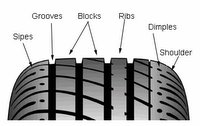A Subset Of Tyre Construction : Tyre tread
 You thought tread was the shape of the rubber blocks around the outside of your tyre didn't you? Well it is, but it's also so much more. The proper choice of tread design for a specific application can mean the difference between a comfortable, quiet ride, and a piss poor excuse for a tyre that leaves you feeling exhausted whenever you get out of your car.
You thought tread was the shape of the rubber blocks around the outside of your tyre didn't you? Well it is, but it's also so much more. The proper choice of tread design for a specific application can mean the difference between a comfortable, quiet ride, and a piss poor excuse for a tyre that leaves you feeling exhausted whenever you get out of your car.A proper tread design improves traction, improves handling and increases Durability. It also has a direct effect on ride comfort, noise level and fuel efficiency. Believe it or not, each part of the tread of your tyre has a different name, and a different function and effect on the overall tyre. Your tyres might not have all these features, but here's a rundown of what they look like, what they're called and why the tyre manufacturers spend millions each year fiddling with all this stuff.

Sipes are the small, slit-like grooves in the tread blocks that allow the blocks to flex. This added flexibility increases traction by creating an additional biting edge. Sipes are especially helpful on ice, light snow and loose dirt.
Grooves create voids for better water channeling on wet road surfaces (like the Aquachannel tyres below). Grooves are the most efficient way of channeling water from in front of the tyres to behind it. By designing grooves circumferentially, water has less distance to be channeled.
Blocks are the segments that make up the majority of a tyre's tread. Their primary function is to provide traction.
Ribs are the straight-lined row of blocks that create a circumferential contact "band."
Dimples are the indentations in the tread, normally towards the outer edge of the tyre. They improve cooling.
Shoulders provide continuous contact with the road while maneuvering. The shoulders wrap slightly over the inner and outer sidewall of a tyre.
The Void Ratio is the amount of open space in the tread. A low void ratio means a tyre has more rubber is in contact with the road. A high void ratio increases the ability to drain water. Sports, dry-weather and high performance tyres have a low void ratio for grip and traction. Wet-weather and snow tyres have high void ratios.




